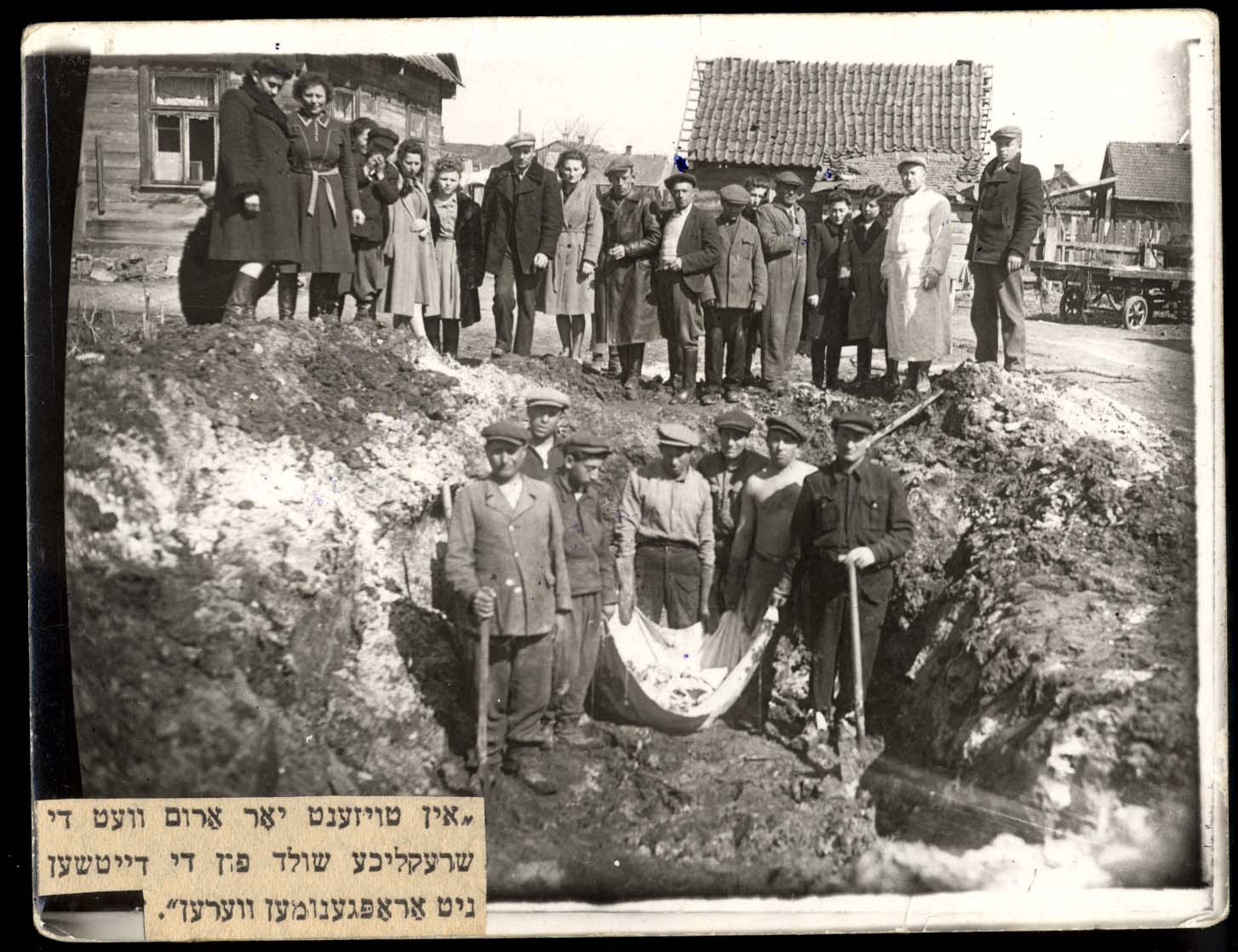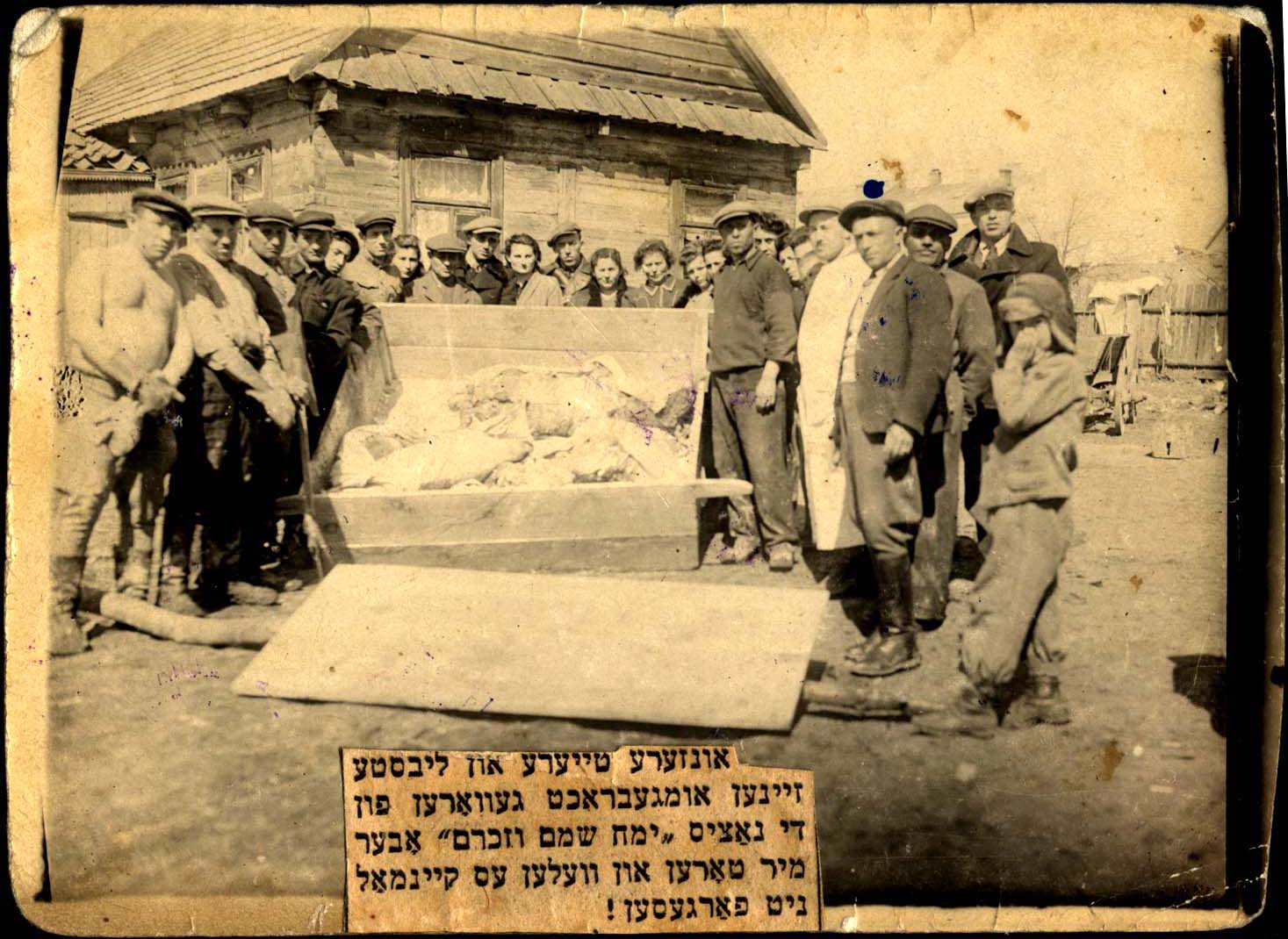
Bielsk Podlaski
Eyewitness
Holocaust testimony of life and death in the Bielsk Podlaski
ghetto
The survivor testimonies below paint a detailed and often vivid picture of life and death in the ghetto. Several of them are from the Bielsk Podlaski yizkor book. Published in 1975, the Yiddish section of the book was translated to English between March and August of 2023. The Hebrew section is currently being translated.
The ghetto was established in August 1941. Local Jews and Jews from nearby towns including Bransk, Bocki, Narew, Orla, and Rutki, were confined there. In addition to those murdered in and around the ghetto, estimates of 11,000 to 15,000 people were transported from the ghetto by train to Treblinka in November 1942. Remaining Jews who could not be transported were murdered in the ghetto.
- The Testimony of Henoch Piasek, from Yad Vashem, describes the creation and liquidation of the Bielsk Podlaski ghetto.
- The Testimony of Sonia Gleicher, from the E. Ringelblum Jewish Historical Institute in Warsaw, provides details about the creation and destruction of the Bielsk Podlaski ghetto.
- The Testimony of Simcha Tepperman and Leizer Davidowicz, from Yad Vashem, regarding the experiences of the Jews of Bielsk-Podlaski under German occupation and in the Bielsk ghetto.
- Accounts of the ghetto as told by priest Eugeniusz Zbigniew Beszta-Borowski, who witnessed events in the ghetto when he was 11 years old, are included in the article From the pages of the city's history. The extermination of the Bielsk ghetto, which also contains a portion of The Testimony of Sonia Gleicher. Let your browser translate the page from Polish to English.
- In The Bielsk Ghetto & The Camps, by Meir Peker, from the Bielsk Podlaski Yizkor Book.
- I Was One of Them, by Favel Shapiro, from the Bielsk Podlaski Yizkor Book, recalls the period from the German invasion to liquidation of the ghetto, and a return to Bielsk after the liberation.
- From the Bielsk-Bialystok Ghettos To Auschwitz-Birkenau, by Mikhal Davidovitch, from the Bielsk Podlaski Yizkor Book.
- “Trifles” about the Great Human-Catastrophe, by Eliezer Davidovitch, from the Bielsk Podlaski Yizkor Book, recalls the period from the Germans crossing the Polish border to the liquidation of the ghetto, and the transport of workers to Bialystok, Birkenau, and Auschwitz.
- A Sixteen Year Old to the Holocaust, by Naftali Grudzinski (Grodnai), from the Bielsk Podlaski Yizkor Book.
- A 13 Year old Bielski in the Days of the Holocaust and Exile, by Yochanan Olejnik (Bashourai), from the Bielsk Podlaski Yizkor Book.
- The Jews of Bielsk Podlaski, a letter written by person known only by their initials, G.V., from the Bielsk Podlaski Yizkor Book, speaks of the liquidation of the ghetto, transport to Treblinka, and survival.
- We Will Not Forget the Bielsk that Was Destroyed, by Chuna Tikotzky, from the Bielsk Podlaski Yizkor Book, describes the liquidation of the ghetto and life in Bielsk after the liberation. To see the letter as originally published on October 7, 1945, in the Morgn Frayhayt (Morning Freedom) New York Yiddish language newspaper, click here.
- In the Holocaust in Russia and also Bielsk Before and After its Destruction, by Yehiel Cherblowsky, from the Bielsk Podlaski Yizkor Book.
- The Last Jews in Bielsk Are Packed and Waiting for a Ship to Israel by S. L. Shnayderman, from the Bielsk Podlaski Yizkor Book. The original publication of this letter on the top of page 2 of the December 27, 1957 issue of the Forverts [Forward] Yiddish newspaper, can be viewed on the Historical Jewish Press collection on the National Library of Israel website. This same chapter appears a second time in the yizkor book with a different title, The Last Jews in Bielsk-Podlaski Ready for Aliyah, sourced from another newspaper. There are differences between the two.
- The Bielsk chapter from the Encyclopedia of Jewish Communities in Poland describes the creation and liquidation of the ghetto.
- Encyclopedia of Camps and Ghettos, 1933-1945 (Volume 2 Part 1, PDF), published by the United States Holocaust Memorial Museum, contains a three-page history of the ghetto. Note that it is within a 135-page section about the Bialystok Region. The Bielsk Podlaski entry begins on numbered page 871. In addition to the sources above, it draws from sources that are not currently available electronically. (All three volumes of the Encyclopedia of Camps and Ghettos can be downloaded for free.)
- "Jews in Bielsk Podlaski County, 1939-1945,” is a chapter in Night Without End, The Fate of Jews in German-Occupied Poland, released in September 2022 and reviewed here. Google Books provides a 77 page preview making the entire chapter, along with the book’s preface, available to read online for free.
- A list of Deportations to Treblinka (on the Svisloch KehilaLinks page) refers to deportations of 11,000 Jews from the Bielsk Podlaski area to Treblinka
- Bielsk is mentioned in the book Lost Jewish Worlds, published by Yad Vashem. The contents of the book were published online. This section mentions Bielsk: Liquidation of the Ghettos and the Deportations to the Camps (November 2, 1942 - March 12, 1942)
- Einsatzgruppen Operational Situation Report, mentions in the second to last paragraph that leaders of the "Jewish intelligentsia" in Bielsk Podlaski had been liquidated.
- A map of the ghetto is included on a memorial plaque that was erected in Bielsk to commemorate the 70th anniversary of the liquidation of the ghetto. A hand drawn map of Bielsk, by Libby Elson, shows the ghetto area in greater detail. This Google map shows the approximate boundaries of the ghetto, as well as its gates, and the following Jewish locations, several of which are mentioned in the Bielsk Podlaski Yizkor Book chapter Centers of Interest in Bielsk:
o Shaarei Zion Beth Midrash (Gates of Zion House of Learning) Synagogue
o Ichel's Beth Midrash Synagogue (Alte Szul - Old Shul)
o Ichel's Torah School
o Beth Midrash Yafeh Einayim (Beautiful Eyes) Synagogue
o Talmudic school
o Mikveh
o Jewish orphanage
o Judenrat office
The photographs below, from Yad Vashem, show the
exhumation of bodies from a mass grave in the ghetto after the
war. Some of the yizkor book chapters linked to above contain
related photos, but they are not nearly as clear as the ones
below.
Exhumation of a mass grave in the former Bielsk Podlaski ghetto, May 1946
A machine translation of the Yiddish caption reads: "In a thousand years, the terrible guilt of the Germans will not be removed." (1)
A machine translation of the Yiddish caption reads: Our dear and loved ones were killed by the Nazis, "May their name and memory be blessed," but we dare and will never forget it! (2)
Photograph
Citations
(1) Bielsk
Podlaski, Poland, 1946, Burial in a mass grave.
Source: https://collections.yadvashem.org/en/photos/98587
Used in
accordance with Yad Vashem's Terms and
Conditions.
Archival
Signature 70DO3
Retrieved on: February 10, 2023
(2) Bielsk Podlaski,
Poland, 1946, Burial in a mass grave.
Source: https://collections.yadvashem.org/en/photos/98584
Used in
accordance with Yad Vashem's Terms and
Conditions.
Archival
Signature 70DO2
Retrieved on: February 10, 2023
Back to Bielsk Podlaski Home Page
Updated
January 4, 2024
Copyright © 2023 Andrew Blumberg
JewishGen Home Page | KehilaLinks Directory
This site is hosted at no cost by JewishGen, Inc., the Home of Jewish Genealogy. If you have been aided in your research by this site and wish to further our mission of preserving our history for future generations, your JewishGen-erosity is greatly appreciated.

